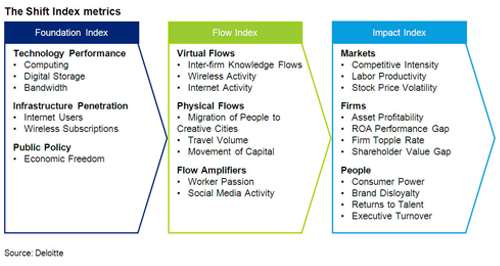The Big Shift in economic structure and why knowledge flows are becoming a fundamentally important business driver
A couple of years ago Deloitte tempted John Hagel away from independent consulting to co-chair a new think-tank, now called the Deloitte Center for the Edge. I have been a long-time fan of John’s work, and find many parallels with my own path and research.
The Center recently released its first major study, the Shift Index, which was accompanied by an article in the July-August issue of Harvard Business Review, titled The Big Shift: Measuring the Forces of Change.
When the Shift Index was first announced, I was immediately drawn to look more closely because of its first key finding:
The performance gap between winners and losers has increased over time, with the “winners” barely maintaining previous performance levels, while the losers experience rapid deterioration in performance.
This matches exactly one of the main messages I have been preaching since the beginning of the recession, for example in my keynotes at the MegaTrends conference in Abu Dhabi and my TEDx presentation in San Francisco on Future of the Enterprise: this is a time of increasing divergence in organizational performance, and adopting new strategies and activities is essential to avoid rapid erosion in competitiveness.
However beyond this core issue, there are many other aspects of the report and analysis that are highly aligned with my own thinking and research. I strongly recommend reading the report, though I have taken a few brief excerpts from the HBR article that I thought were particularly worth noting:
The number and quality of knowledge flows at a firm – partly determined by its adoption of openness, cross-enterprise teams, and information sharing – will be key indicators of its ability to… turn performance challenges into opportunities. The ultimate differentiator across companies, though, may be a competency for creating and sharing knowledge across enterprises.
This is precisely why I wrote Developing Knowledge-Based Client Relationships, which came out in its first edition in 2000. At the time I considered it a book about the future of business, and indeed knowledge flows across organizational boundaries are becoming ever more critical to business performance.
The initial findings from our research indicate a correlation between the rapidly growing use of social media and the increasing knowledge flows between organizations.
This is a point that many are missing in the hype around social media – in a business context perhaps social media’s most powerful application is to cross-organizational communication and relationships. Companies that can leverage their own capabilities creating business value through the internal use of social media can build exceptional client, supplier, and partner relationships, which are absolutely the foundation of competitive differentiation in a connected world.
As some organizations participate more in knowledge flows, we should see them break ahead of the pack and significantly improve overall performance in the long term. Others, still wedded to the old ways of operating, are likely to deteriorate quickly.
In a world of rapidly diverging organizational performance, these are not issues that can be ignored. Capabilities at knowledge flows are underpinned by culture, governance, structure, and processes, and these must be developed over time, as reflected in my Enterprise 2.0 Implementation Framework.
One of the easiest and most powerful ways firms can achieve the performance improvements promised by technology is to jettison management’s distinction between “creative talent” and the rest of the organization. All workers can continually improve their performance by engaging in creative problems solving, often by connecting with peers inside and outside the firm.
This is a fundamental point. Companies can now use “technologies of connection” to tap the potential contribution of all their staff. In a networked world, it is possible to unleash the power of many as never before.
I’m very pleased to see the rich research supporting the Shift Index, and the communication power of Deloitte behind getting these important insights out. I will certainly continue to work hard communicating very similar messages to the executives who most need to hear them.

